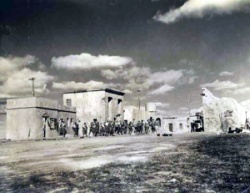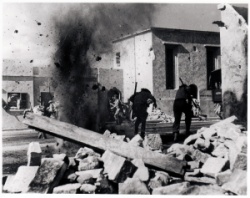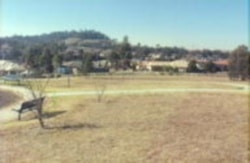RATS OF TOBRUK – 1944
A story of Aussie heroism in the Tobruk chapter of World War 1, when men of the AIF, living in dugouts and conducting silent raids at night, held Tobruk against the German forces for an exhausting eight months.
“Rats of Tobruk” was a hard-working production made under wartime conditions; finance and equipment were scarce, major studios closed and many actors and personnel had joined the armed forces. It was not the blockbuster of its predecessor, ‘Horsemen’, but a sincere portrayal of the Australian soldiers’ mateship and stoicism while defending Tobruk. It was generously assisted by all three armed forces, in order to ensure authenticity.
The film starred Peter Finch, Grant Taylor and Chips Rafferty. They were given temporary leave to appear in the film – once again it was seen as a wartime morale booster. The romance and comedy segments were made almost at the last minute, to comply with the demands of the film’s backers, and are out of step with the rest of the film. In USA, the American version titled “The Fighting Rats of Tobruk” cut some of these giving the film a better flow.
As the same troops had been shipped to New Guinea to fight the Japanese almost immediately after their withdrawal from Tobruk, Chauvel included a final sequence filmed in Canungra Gorge, southeast Queensland; this was to bring the story in line with events that had recently taken place.
Partly ruined portions of the town of Tobruk were reconstructed on top of CURRANS HILL, near Narellan, NSW, where bombing raids were filmed. Other locations were at SINGLETON, NSW, where scenes of a massed German tank attack were filmed on a nearby plain, and KURNELL, where the sandhill country was used again for shots of desert warfare at night. CANUNGRA GORGE, Southeast Qld. provided the New Guinea background.
Excerpt from biography:
“On the sandhills, engineers wired the dunes with thirty-two large, explosive devices. Climatic conditions delayed and frustrated the team. Sandstorms filled in the trenches faster than they could be dug and buried the guns. In wet weather it was necessary to keep removing the detonators. For night scenes of the Australian soldiers attacking enemy gun positions, Chauvel had a huge dynamo hauled across the sands, to provide the arc lights needed. On fine nights, this provided a Sound and Light show for Cronulla residents who lined up along the seafront eight miles away, to watch the Very lights exploding and floating down like miniature fireworks.
On the set it was a world of dust, barbed-wire, guns and noise, as tin-hatted Australian diggers aimed at German infantry advancing behind shellfire. Years later one of the extras told a reporter that Chauvel offered a bottle of beer to the man who ‘died’ most convincingly!”



